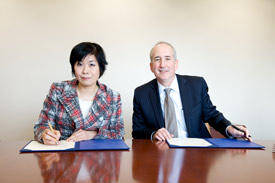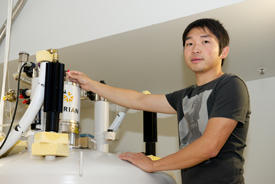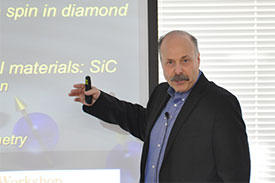

09/29/2014

Two years ago, AIMR Director Motoko Kotani initiated the consolidation of the institute’s many international alliances into focused centers for collaborative, multidisciplinary and high-impact research. This year, that effort continues with the introduction of an exciting new venture in the United States.
On 16 April, the AIMR signed an agreement to establish a joint research center with the University of Chicago, expanding on its three existing partnerships with the University of Cambridge, the Institute of Chemistry at the Chinese Academy of Sciences and the University of California, Santa Barbara (UCSB).
As well as enabling the two-way transmission and generation of knowledge through joint laboratories, workshops and researcher exchanges, this new connection further reinforces the strong relationship between two leading researchers in the field of spintronics — Hideo Ohno and David Awschalom. Ohno, a principal investigator at the AIMR, was the first to discover ferromagnetism in a superconductor, and he later developed an electrical ‘switch’ for turning a permanent magnet on and off. And Awschalom, a principal investigator at the University of Chicago’s Institute for Molecular Engineering (IME), experimentally observed a phenomenon known as the spin Hall effect, which had been theoretically predicted over 30 years earlier. These and many other electron-spin-related discoveries in the last decades can enable faster information processing and data storage in spintronic devices.

The new Chicago relationship adds to an existing international partnership in the United States with UCSB. Researchers at the AIMR–UCSB joint research center are making unexpected connections in organic electronics, which may spawn an entirely new area of research.
As most organic radicals are highly unstable, researchers have tended to avoid investigating their potential for organic electronics. But Fred Wudl, chemistry and materials professor at UCSB and adjunct professor at the AIMR, wondered whether these radicals could be used in electronic devices. He posed the challenge of exploring this idea to AIMR–UCSB joint scientist Yonghao Zheng, who is currently based at Wudl’s lab in Santa Barbara. The exercise proved worthwhile — Zheng discovered that the electronic properties of a stable organic radical can be simply altered by changing its temperature.
“This is a really exciting finding and could open up a new area of research for organic electronics,” says Zheng. Organic materials are particularly attractive for use in electronics because their properties can be fine-tuned much more easily than inorganic materials, and they can be mass produced using simple, low-cost methods. Eventually, these materials could bring us flexible television screens and transparent photovoltaic wallpaper. “Organic electronics have the potential to make our lives more beautiful,” says Zheng.
In addition to studying the electronic properties of organic radicals, Zheng plans to investigate their magnetic properties by collaborating with principal investigator at the AIMR, Katsumi Tanigaki, an expert on magnetism. Zheng also hopes to engage with the mathematicians at the AIMR to gain a better understanding of the reasons behind the phenomena he observes experimentally. A similar partnership has already been established at the AIMR between Hiroyuki Isobe, a principal investigator in the area of organic synthesis, and Director Kotani, who is a mathematician. Recently, this pair used geometry to describe and measure the length of finite-sized carbon nanotube molecules. “The AIMR is like one big family,” says Zheng. “Everyone works very closely together, which really speeds up research.”
Besides inspiring groundbreaking research, the collaboration between UCSB and the AIMR has benefited early career researchers like Zheng in many ways. “As a joint scientist, I have access to fabulous equipment at the UCSB Materials Department and can exchange ideas with top-level professors.” The experience has expanded his research network and broadened his perspective. Crucial to that process have been the regular meetings and workshops between the two institutes, particularly the joint seminar hosted by UCSB in January 2012, with the AIMR returning the favor in February 2013.

In September this year, the AIMR organized a workshop to deepen their new alliance with the University of Chicago. “The AIMR is thrilled to enter into its first international partnership with the University of Chicago and to strengthen its relationships through the workshop,” says Kotani, who opened the session. Throughout the two-day event, chemists, physicists, mathematicians and materials scientists deliberated on a host of topics, including the quantum manipulation of matter, energy harvesting and storage, and the mechanics of breathing.
Among the presenters at the meeting was Shin-Ichi Orimo, a principal investigator at the AIMR, who highlighted the stable and fast conduction properties of lightweight complex hydrides, which could be exploited for hydrogen storage as well as in lithium rechargeable batteries. Also, Ka Yee Lee, a professor at the University of Chicago, shared her research on lung surfactant, a lipid and protein complex that coats the alveoli and eases breathing by reducing surface tension. Her research could help to improve the design of artificial lung surfactants to treat diseases characterized by surfactant deficiency.
“The inaugural workshop highlighted a variety of emerging research opportunities where we hope to develop productive collaborations with our colleagues in Sendai, driven by young researchers from both institutes,” says Awschalom, who is now taking spintronics into the realm of quantum information engineering. Awschalom was one of six participants from the University of Chicago who traveled to Japan to exchange ideas with six counterparts from the AIMR.
Also from the University of Chicago, Professor Andrew Cleland discussed his latest successes in harnessing quantum-mechanical phenomena for the development of nanomechanical systems and devices. Cleland’s team was the first to construct a machine whose movement followed the peculiar laws of quantum mechanics, previously only observed in nanoscopic particles. By coupling optical, mechanical and microwave electrical signals, Cleland and Awschalom could bring us closer to high-speed quantum communications and long-term storage of quantum information.
“The diversity and breadth of subjects covered at the workshop are an asset to our understanding and utilization of materials and phenomena at the nano- and molecular scale,” says Ohno from the AIMR. “I am fully convinced that this and following meetings will lead us to new directions and discoveries.” Ohno’s confidence is reinforced by the tangible successes that the AIMR has thus far achieved through its joint research centers, whether in Santa Barbara, Cambridge or Beijing.